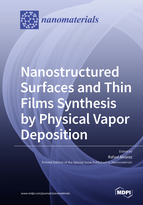Nanostructured Surfaces and Thin Films Synthesis by Physical Vapor Deposition
A special issue of Nanomaterials (ISSN 2079-4991). This special issue belongs to the section "Synthesis, Interfaces and Nanostructures".
Deadline for manuscript submissions: closed (21 July 2020) | Viewed by 37320
Special Issue Editor
Departamento de Física Aplicada I. Universidad de Sevilla, 41011 Seville, Spain
Interests: nanostructured thin films; oblique angle deposition; magnetron sputtering; nanoporosity; growth simulation
Special Issue Information
Dear Colleagues,
The synthesis of nanostructured surfaces and thin films by means of physical vapor deposition is currently a field of great interest in both scientific and technological aspects. Techniques such as pulsed laser deposition, magnetron sputtering, HiPIMS, or e-beam evaporation, among others, are key for the development of applications in photovoltaic cells, tribological coatings, optofluidic sensors, or biotechnology, to name a few. The nanostructuration of the surface allows for the tailoring of the way a material interacts with the environment, providing a tuning mechanism for its properties, be them optical, mechanical, electrical, tribological, or chemical. Unfortunately, the processes responsible for the formation of a certain nanostructure are, in most of the cases, not known with the sufficient depth to gain such a level of control. It is then necessary to study these nanostructuration mechanisms from both a technological point of view, by creating surfaces with novel nanostructures and applications, and by addressing more fundamental issues so that these processes are better understood.
This Special Issue invites manuscripts that present significant advances concerning both fundamental and applied research topics, which include but are not limited to the following:
- Thin film nanostructuration processes;
- Nanostructural properties;
- Anisotropic nanostructured surfaces;
- Atomistic processes during film synthesis;
- Simulation of nanostructured surfaces;
- Applications of nanostructured thin films;
- Devices.
Dr. Rafael Alvarez
Guest Editor
Manuscript Submission Information
Manuscripts should be submitted online at www.mdpi.com by registering and logging in to this website. Once you are registered, click here to go to the submission form. Manuscripts can be submitted until the deadline. All submissions that pass pre-check are peer-reviewed. Accepted papers will be published continuously in the journal (as soon as accepted) and will be listed together on the special issue website. Research articles, review articles as well as short communications are invited. For planned papers, a title and short abstract (about 100 words) can be sent to the Editorial Office for announcement on this website.
Submitted manuscripts should not have been published previously, nor be under consideration for publication elsewhere (except conference proceedings papers). All manuscripts are thoroughly refereed through a single-blind peer-review process. A guide for authors and other relevant information for submission of manuscripts is available on the Instructions for Authors page. Nanomaterials is an international peer-reviewed open access semimonthly journal published by MDPI.
Please visit the Instructions for Authors page before submitting a manuscript. The Article Processing Charge (APC) for publication in this open access journal is 2900 CHF (Swiss Francs). Submitted papers should be well formatted and use good English. Authors may use MDPI's English editing service prior to publication or during author revisions.
Keywords
- Thin film growth
- Nanostructure
- Nanoporous surface
- Synthesis methods
- Physical vapor deposition
- Surface properties







